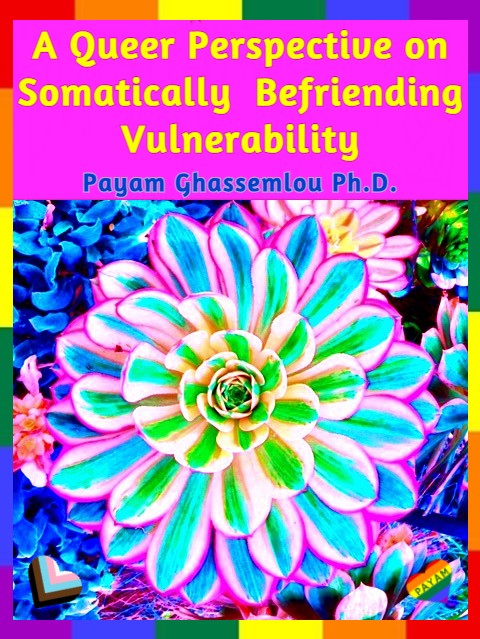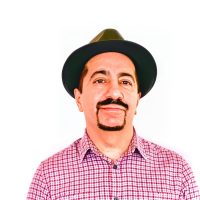Since being vulnerable does not always come easily to many of us, it is important to have empathy for anyone who struggles with it. The internet is flooded with writings and talks on encouraging people to show vulnerability. Having trouble expressing it often gets associated with a lack of authenticity. Such judgmental interpretations can frequently trigger shame in people who don’t feel safe enough to be vulnerable due to certain socio-demographic factors. There is a misconception that expressing vulnerability is a matter of courage or just making a mental decision. By helping others reclaim it, I have realized the issue has little to do with bravery or honesty. It has more to do with the state of one’s nervous system. By having a somatic perspective on understanding vulnerability, we can open a new path toward befriending it.
There are many different paths toward befriending vulnerability which includes using the body to build a greater capacity to embrace it. Our response to many emotional experiences can be felt in our bodies. For example, Lucas, a 30-year-old cis gender gay man, disclosed having difficulty asking guys on dates. Doing so makes him feel very vulnerable. Among other bodily reactions, he reported tightness in his chest along with uncomfortable restricted breathing when faced with uncertainty to his invitation. Lucas has a history of growing up with the stress of homophobic mistreatment. He often felt unsafe at school due to the devastating experience of being bullied or called derogatory names. Fight or flight was not an option when he was feeling helpless and hopeless dealing with his traumatic school environment. Instead, his body resorted to numbing and shutting down. This response became his default whenever faced with overwhelming situations like entering a vulnerable state. Lucas’ reactions to becoming vulnerable had nothing to do with a choice or a lack of courage. It had more to do with his body’s threat alarm being frequently on.
In general, LGBTQ children are often at risk for being bullied, and they need protection. Lucas and many other queer youngsters growing up place their trust in individuals and institutions who were supposed to protect them from harm. Failure to receive such a protection at a critical developmental phase became a source of hurt and betrayal. The trauma of growing up gay in a world that did not embrace LGBTQ identity with kindness and acceptance led Lucas and many others to associate vulnerability with fear and betrayal. Given his traumatic history, Lucas needed help learning how to feel safe in his body when becoming vulnerable. Regulation of his psychophysiological arousal in response to vulnerability has been an important healing task for Lucas, especially when it came to making connections with other single gay men.
Taking a somatic approach toward working with vulnerability involves understanding the role of the autonomic nervous system (“ANS”). The ANS is the part of the nervous system that governs the fight, flight, or freeze instinct and is responsible for the unconscious bodily functions like breathing, digesting food, and regulating the heart rate. It also plays a vital role of supplying information from our organs to our brain. This system works automatically (autonomously), without a person’s conscious effort. The ANS is central to our experience of safety, connection with others, and our ability to bounce back from life’s overwhelming experiences. Relying on neuroception, a term coined by Dr. Stephen Porges, our ANS can differentiate between safety, danger, and a life threat. Neuroception, as Deb Dana (author of The Polyvagal Theory in Therapy) explains, is automatic, and it does not go through the thinking part of our brain. Everything from sound to smell to temperature in our environment, people’s tone of voice, and eye contact can influence our neuroception. It is like “internal surveillance” that looks for cues of safety and danger inside the body, in one’s environment, and in relationship with people. It helps us take immediate action in the face of danger or threat. The goal of neuroception is to keep us safe and alive. Based on my training in Somatic Experiencing®, Touch Skills Training for Trauma Therapists, Polyvagal Theory, and other body inclusive approaches, I have learned the autonomic nervous system is a relational system that has been shaped by experience. We now know previous negative life experiences and traumas can significantly affect how our neuroception accurately assesses safety, danger, or a life threat. This can explain why many people including Lucas with history of being judged, humiliated, and violated often avoid entering a vulnerable state. Their faulty neuroception causes them to feel unsafe in the absence of real danger.
Since “how we move through the world is guided by our ANS,” it is important to examine how growing up in a homophobic and transphobic environment negatively affected the working of the ANS. In my counseling work with gay, lesbian, bisexual, queer identified, and transgender people who have experienced homophobic or transphobic mistreatment, I have noticed their nervous systems are often shaped toward self-protection versus making connections. Repeated past humiliation and rejection by others have made it difficult for many of them to be open and willing to love and be loved. Given the important role that ANS can play in people’s ability to embrace vulnerable situations and form relationships, it is important to learn how to regulate it. When working in a regulated way, the ANS does not enact the response to the present moment situation based on one’s past conditioning.
Autonomic regulation has less to do with talking about our past trauma events and more to do with shifting our autonomic state that can be stuck on FFF (fight/flight/freeze) toward safety and relaxation. When Lucas was invited to share about his history, it was done for the purpose of having greater empathy for his suffering and learning how fear became associated with vulnerability. Lucas’ personal stories with homophobic mistreatment was handled with care and in a titrated manner to avoid re-traumatization. In general, encouraging people to get into their trauma stories all at once can become overwhelming for them because the nervous system cannot tell the difference between the original event and the telling of the event. Healing does not always need to involve re-telling the story. As Peter Levine, the founder of Somatic Experiencing International, stated, “Trauma is not in the event, but in the nervous system.” Based on my personal and clinical work, I also concur that trauma becomes embodied during a person’s life and can affect the working of the ANS. Much of the healing from this trauma needs to happen through the body. In particular, the nervous system needs to be regulated.
The work of Stephen Porges’ Polyvagal Theory has brough to light the role of the vagus nerve in how we experience safety and connection. The vagus nerve which is divided into two pathways, the dorsal vagus and the ventral vagus, is the main component of the parasympathetic nervous system. The ventral vagal of parasympathetic system plays a crucial role in our experience of safety in our bodies. Activation of the ventral vagal force in the ANS includes but not limited to awareness and tracking of pleasant bodily sensations. For example, when I invited Lucas to notice his body being supported by the couch, he commented, “I can sense my body feels relaxed and comfortable.” By bringing awareness to comfortable sensations in his body, he began to breathe deeper and noticed a sense of expansion in his chest area along with his shoulders becoming more relaxed. For Lucas, tracking bodily sensations that were comfortable invited the flow of the ventral vagal of safety and connection.
Another useful somatic intervention involved identifying and embodying helpful resources that contributed to his healing journey. For example, attending LGBTQ Pride events and volunteering at the Los Angeles LGBT+ Community Center felt empowering for Lucas. By tracking his pleasant bodily sensations as he was sharing about these helpful resources, he was creating a physiological event in his body which contributed to regulating his nervous system. As the therapy session progressed, he found it easier to imagine and plan on asking a guy he met at his gym on a date without experiencing tension in his body. Repeated awareness of pleasant sensations in his body increased his ability to distinguish sensations of distress versus sensations of well-being. The more he focused on what felt good on the inside the more his autonomic dysregulation settled, and his window of tolerance expanded.
What makes each one of us feel vulnerable is unique and personal. What feels vulnerable to Lucas can feel quite different to another. Regardless of what activates it, the admission ticket to a more meaningful life for Lucas involved embracing vulnerability. It was important for him to liberate vulnerability from years of cumulative stress of dealing with homophobic bullying, and other fearful situations that he had to endure. By welcoming vulnerability and learning how to work with its transformative power, he was able to enrich his life. A “body-inclusive” therapeutic approach offered Lucas tools and practices to lower his activation and regulate his nervous system in response to his life stresses.
*Names and other details have been changed for privacy and confidentiality.











Read 0 comments and reply